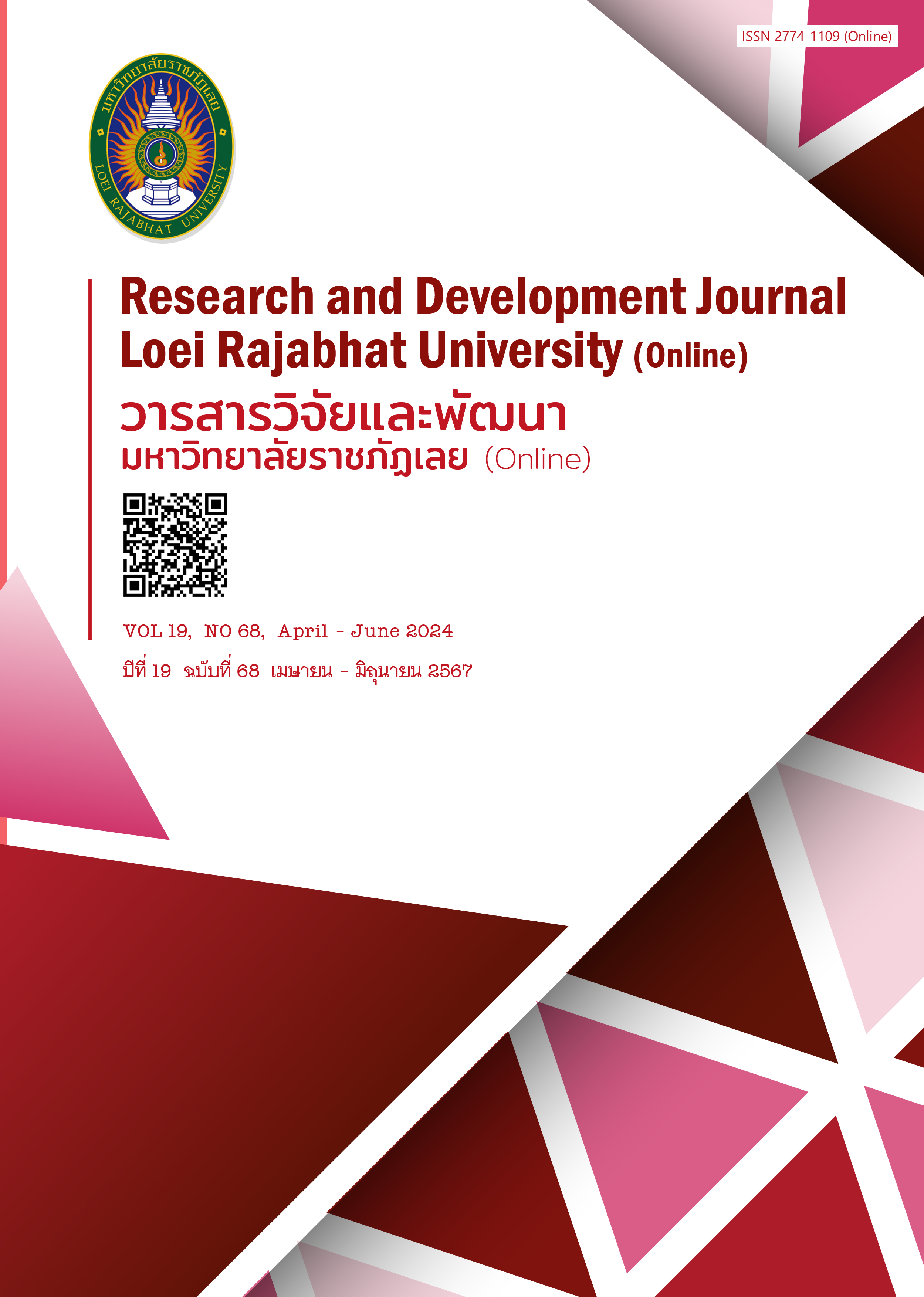Influences of Content Marketing on Tourism Decisions Making in Khon Kaen Province
Keywords:
content Marketing, tourism decisions making, Khon Kaen provinceAbstract
This study aimed to investigate the tourists’ using social media behavior in Khon Kaen province and study content marketing influencing the decision-making to travel to Khon Kaen Province. This was a quantitative research study using questionnaires collected from a group of 400 tourists who were traveling to Khon Kaen province. The statistics used in the data analysis included percentages, means, and standard deviations. The inferential statistical analysis was a multiple linear regression analysis.
The research results found that most Thai tourists are female, aged 18 – 22 years, had average-income students. Most of them have less than 10,000 baht and domicile from the northeast. For the use of social media behavior, the most frequently used application was Instagram at 38.80 percent. The frequency of social media usage per day was mostly more than 7 times per day at 65 percent. The duration of social media usage was more than 1.30 hours at 34.30 percent. The most use of social media period was between 20.00 - 00.00 hours at 58.80 percent. The purpose that most respondents were interested in on social media was for entertainment at 40.7 percent. The content that respondents chose to remember the most through social media was mostly video at 51 percent. For hypothesis testing, it was found that tourism video content, tourism photo album content, and travel quotes content had a significant positive influence on travel decision making to Khon Kaen province at a significant level of 0.01, and tourism promotion content had a positive influence on travel decision making to Khon Kaen province at a significant level of .05. However, live-streaming content had no significant influence on the travel decision making to Khon Kaen province.
References
กิติยา เด่นชัย. (2557). พฤติกรรมการใช้และการรับรู้ข้อมูลผ่านสื่อสังคมออนไลน์ที่มีผลต่อการตัดสินใจเลือกแหล่งท่องเที่ยว และสถานที่พักของนักทองเที่ยวชาวไทยในเมืองพัทยา (วิทยานิพนธ์ปริญญามหาบัณฑิต). มหาวิทยาลัยกรุงเทพ, กรุงเทพฯ.
ฤทัย เตชะบูรณเทพาภรณ์. (2554). แรงจูงใจและปัจจัยทางการตลาดบนเฟซบุค (Facebook) ที่มีผลต่อการตัดสินใจซื้อสินค้าและบริการของผู้บริโภคในเขตกรุงเทพมหานคร (วิทยานิพนธ์ปริญญามหาบัณฑิต). มหาวิทยาลัยกรุงเทพ, กรุงเทพฯ.
วสิษฐา เปี่ยมสกุล. (2554). การศึกษาศักยภาพการท่องเที่ยวของจังหวัดขอนแก่น (วิทยานิพนธ์ปริญญามหาบัณฑิต). จุฬาลงกรณ์มหาวิทยาลัย, กรุงเทพฯ. สืบค้นจาก http://tourismlibrary.tat.or.th/medias/CU0117/CU0117_fulltext.pdf
อัจฌิรา ทิวะสิงห์, พิมพิกา ทองรมย์, พิมอร แก้วแดง, ฐิญาภา เสถียรคมสรไกร, และ พนัส สืบยุบล. (2562). พฤติกรรมการตัดสินใจท่องเที่ยวและการใช้สื่อสังคมออนไลน์ของนักท่องเที่ยวไทย. วารสารวิชาการ, 13(3), 100-107.
ปรานี ปวีณชนา. (2563). เหรียญสองด้านของโซเชียลมีเดีย. สืบค้นจาก. https://www.manarom.com/blog/the_two_sided_coin_of_social_media.html
พันธกานต์ วรวัฒน์นานนท์. (2563). Content Marketing คืออะไร ทำอย่างไรให้ประสบความสำเร็จ. สืบค้นจาก https://searchstudio.digital/th/marketing/what-is-content-marketing/
Bufquin, D., Park, J., Back, R., Nutta, M., and Zhang, T. (2019). Effects of hotel website photographs and length of textual descriptions on viewers’ emotions and behavioral intentions. International Journal of Hospitality Management, 89(2). doi:10.1016/j.ijhm.2019.102378
Cao, X., Qu, Z., Liu, Y., and Hu, J. (2021). How the destination short video affects the customers’ attitude: The role of narrative transportation. Journal of Retailing and Consumer Services, 62. Doi: 10.1016/j.jretconser. 2021.102672
Cochran, W. G. (1974). Sampling Techniques. New York: Wiley.
Cronbach, L. J. (1990). Essentials of Psychological Testing (5th ed.). New York: Harper Collins.
Digimusketeers. (2023). Content marketing. Retrieved from https://digimusketeers.co.th/blogs/
Evans, N., and McKercher, B. (2019). Understanding Tourism Marketing: A Response to How Content is Used. Journal of Travel Research, 58(8), 1283–1293. Doi:10.1016/j.tmp.2018.12.001
Hulisi B. (2019). What is the Motivation of Travellers? An investigation of quotes on Trip Advisor’s facebook page. International Journal of Marketing, 5, 76-92. Doi: 10.54663/2182-9306
Jiang, J., Hong, Y., Li, W., and Li, D. (2022). A study on the impact of official promotion short videos on tourists’ destination decision-making in the post-epidemic era. Frontiers in Psychology, 13. Doi: 10.3389/fpsyg.2022. 1015869
Karlis, D., and Ntzoufras, I. (2003). Analysis of sports data by using bivariate Poisson models. Journal of the Royal Statistical Society: Series D (The Statistician), 52(3), 381-393. Doi:10.1111/1467-9884.00366
Kleinbaum, D. G., Kupper, L. L., Nizam A., and Rosenberg, L. L. (2014). Applied Regression Analysis and Other Multivariable Methods (5th ed). USA: Cengage Learning.
Morosan, C. and Jeong, N. (2008). The role of the Internet in the process of travel information search. Information Technology in Hospitality, 51, 13- 23. Doi:10.3727/154595308784670242
Munar, A. M., and Jacobsen, J. K. S. (2014). Motivations for sharing tourism experiences through social media. Tourism Management, 43, 46-54. Doi: 10.1016/j.tourman.2014.01.012
Naidoo, V., and Hollebeek, L. D. (2016). Higher education brand alliances: Investigating consumers' dual-degree purchase intentions. Journal of Business Research, 69(8), 3113-3121. Doi: 10.1016/j. jbusres.2016.01.027
Pan, B., MacLaurin, T., and Crotts, J.C. (2007). Travel blogs and the implications for destination marketing. Journal of Travel Research, 46, 35-45. Doi: 10.1177/0047287507302378
Shin, N., and Chen, Q. (2016). An exploratory study of nonprofit organisations' use of the internet for communications and fundraising. International Journal of Technology, Policy, and Management, 16(1), 32-44. Doi: 10.1504/IJTPM. 2016.075937
Tarigan, M.I. (2022). The Effect of Social Media-Based Promotion on Tourism Decisions-Making. International Journal of Environmental, Sustainability, and Social Sciences, 3(2), 504-511. Doi: 10.38142/ijesss.v3i2.328
Terttunen, A., (2017). The influence of Instagram on consumers’ travel planning and destination choice. (Bachelor thesis). Haaga-Helia University of Applied Sciences. Helsinki, Finland
Werthner, H., and Ricci, F. (2004). E-commerce and tourism. Communications of the ACM, 47(12), 101-105. Doi: 10.1145/1035134.1035141
Wongkitrungrueng, A., and Assarut, N. (2020). The role of live streaming in building consumer trust and engagement with social commerce sellers. Journal of Business Research. 117, 543-556. Doi: 10.1016/j.jbusres.2018.08.032
Yu, J. (2020). Government affairs new media: research on transmission of short videos in public emergency (in Chinese). Journal of Henan University (Social Science Edition), 60, 125-130. Doi: 10.15991/j.cnki. 411028.20 20.06.020
Zikmund, W. G., Babin B. J., Carr, J. C., and Griffin, M. (2010). Business Research Methods (8ed.). UK: South-Western Cengage Learning.
Downloads
Published
How to Cite
Issue
Section
License
Copyright (c) 2024 Research and Development Journal, Loei Rajabhat University

This work is licensed under a Creative Commons Attribution-NonCommercial-NoDerivatives 4.0 International License.
ข้อความที่ปรากฎในวารสารฉบับนี้เป็นความคิดเห็นของผู้เขียนแต่ละท่าน สถาบันวิจัยและพัฒนา มหาวิทยาลัยราชภัฏเลย และกองบรรณาธิการ ไม่จำเป็นต้องเห็นด้วยและไม่มีส่วนรับผิดชอบใดๆ
สถาบันวิจัยและพัฒนา มหาวิทยาลัยราชภัฏเลย ขอให้ผู้อ่านอ้างอิงในกรณีที่ท่านคัดลอกเนื้อหาบทความในวารสารฉบับนี้






